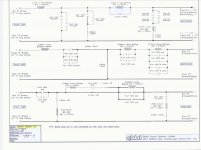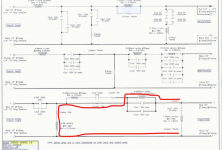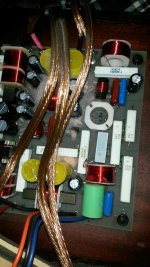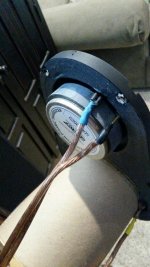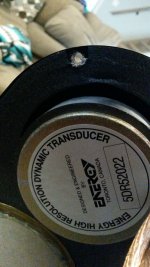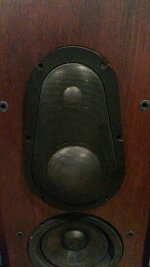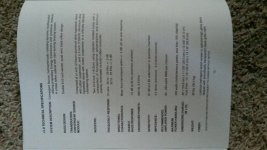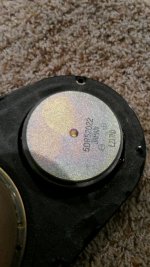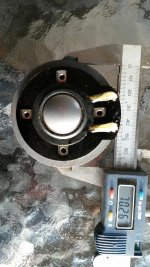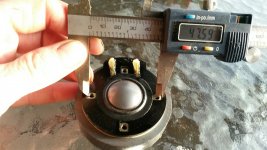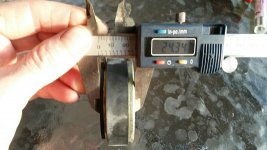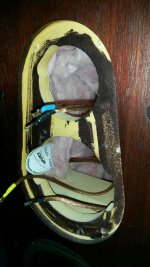Wondering if the capacitors may have failed on the crossover rather than going worst case scenario and thinking tweeters are burnt.
I pulled out the tweeter/midrange unit far enough to get an ohm meter on the speaker terminals and get 8.0 ohms on tweeter and 3.0 on midrange. Midrange is making sound. So I don't think the tweeter is open or shorted but don't know proper spec to be sure. Leads are soldered so haven't disconnected right at tweeter.
These speakers are 25 years old now so wondering if it could be a crossover issue.
I don't even know where the crossover is or how to access. No obvious panel unless I must pull one of the base drivers out to access.
Is it possible the input caps are gone or is it wishful thinking?
I pulled out the tweeter/midrange unit far enough to get an ohm meter on the speaker terminals and get 8.0 ohms on tweeter and 3.0 on midrange. Midrange is making sound. So I don't think the tweeter is open or shorted but don't know proper spec to be sure. Leads are soldered so haven't disconnected right at tweeter.
These speakers are 25 years old now so wondering if it could be a crossover issue.
I don't even know where the crossover is or how to access. No obvious panel unless I must pull one of the base drivers out to access.
Is it possible the input caps are gone or is it wishful thinking?
Attachments
Missed that path through the inductor. I found the crossover is attached to base plate of speaker. The melted metal on 10w resistor seems out of place.
I will unsolder the lead on the crossover output and get a reading on tweeter tonight.
I will unsolder the lead on the crossover output and get a reading on tweeter tonight.
Attachments
Reading open circuit on tweeter with the one wire lifted off the crossover so looks like I need to find some tweeters. How would I go about finding replacements? I can try Klipsch since I understand they bought out Energy. Is there some company out there that I can contact who can offer a comparable replacement?
That 4.0 ohm 10w resistor with brown spot it is 4.3 ohm so is ok. Must be a stray dab of glue got on it.
Thanks
That 4.0 ohm 10w resistor with brown spot it is 4.3 ohm so is ok. Must be a stray dab of glue got on it.
Thanks
In the picture it looks almost like a solder splash... it's local and looks to be caused by something external during assembly. I'd just pick it off.
Replacements... I'm afraid my expertise runs out with the circuit theory as I've no idea what would be a suitable replacement for these. Hopefully someone else will pick up on this and be better able to advise.
as I've no idea what would be a suitable replacement for these. Hopefully someone else will pick up on this and be better able to advise.
Replacements... I'm afraid my expertise runs out with the circuit theory
This appears to have been rewired. Is the discolouration beneath the blue capacitors some kind of chemical residue?
To help you pick a replacement tweeter, is there some kind of technical specifications paper on the web or sticker or plaque on the speaker? I'd be interested in the sensitivity at least.
There are a few different levels of replacement method, maybe the nominal impedance of the original tweeter would come in handy?
To help you pick a replacement tweeter, is there some kind of technical specifications paper on the web or sticker or plaque on the speaker? I'd be interested in the sensitivity at least.
There are a few different levels of replacement method, maybe the nominal impedance of the original tweeter would come in handy?
I have had these units since around 2004. Bought off a hifi salesman that had them at home, dealt with the guy for a few years so knew him well enough. Don't think they ever had work done on them since I never had reason to open one up. So any discoloration that is not an outright failed item would be from factory.
Can't find anything on the internet with any other specifics to the tweeters. The crossover diagram came from this site. I can attach the specs from my owners manual but no other details can be found going through the booklet.
I admit that perhaps it is time to get into some new speakers but would like to make these fully serviceable again so they have some resale. I could part them out I suppose. I do lots of things myself but speakers are not something I ever looked into so have no idea how I could go about this or what resources are out there to assist me. And the fact that the mid and tweets are in a sub assembly makes it even more challenging for someone with no background at all in such diy work. And so I am here posting.
Any help would be greatly appreciated. If they weren't such a nice speaker for my tastes I would toss them and move on.
Can't find anything on the internet with any other specifics to the tweeters. The crossover diagram came from this site. I can attach the specs from my owners manual but no other details can be found going through the booklet.
I admit that perhaps it is time to get into some new speakers but would like to make these fully serviceable again so they have some resale. I could part them out I suppose. I do lots of things myself but speakers are not something I ever looked into so have no idea how I could go about this or what resources are out there to assist me. And the fact that the mid and tweets are in a sub assembly makes it even more challenging for someone with no background at all in such diy work. And so I am here posting.
Any help would be greatly appreciated. If they weren't such a nice speaker for my tastes I would toss them and move on.
Attachments
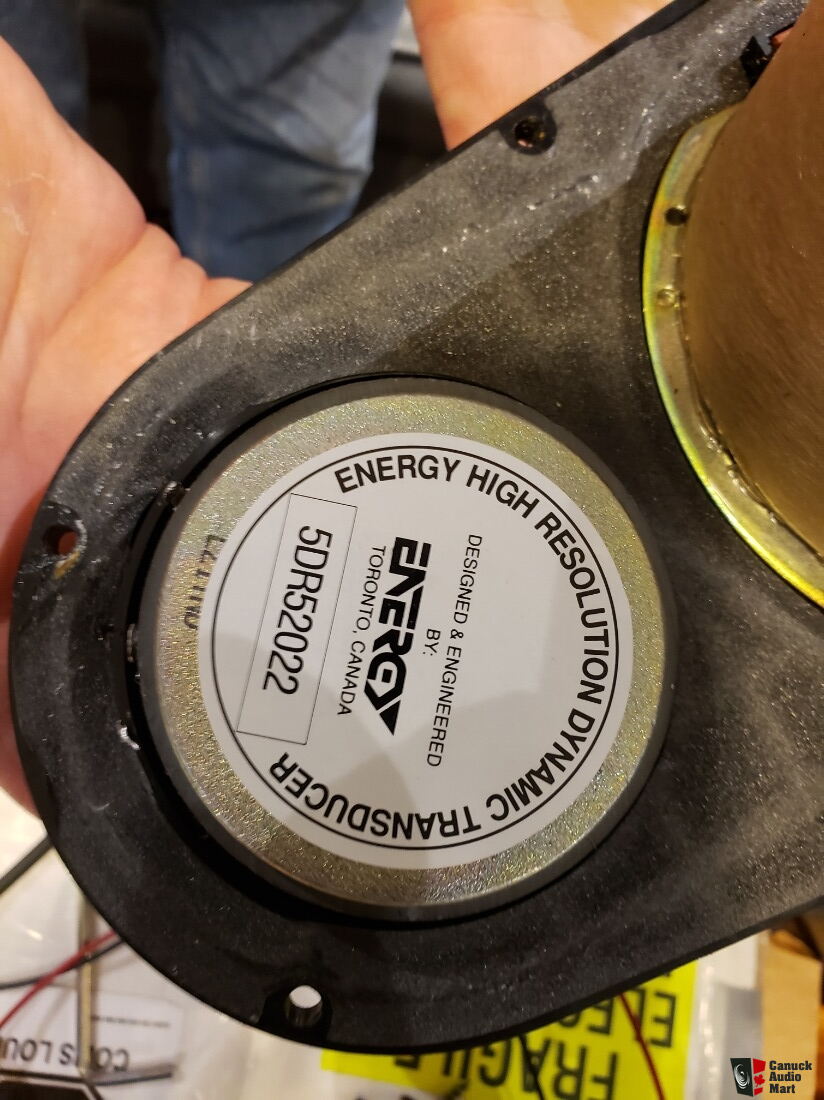
I'd suggest that you completely remove that tweeter ( from the plastic housing ) and then take a series of pics showing the tweeter from all angles.
The aluminum dome and large/thick ceramic magnet imply a certain level of quality.
The fact these speakers were from the 1990's ( when Dynaudio still supplied components directly through Solen in Montreal ) suggests a possible supply chain.
There are plenty of 1" ( aluminum dome ) enthusiasts around here ( and other forums ) that can should be able to make an educated guess at to what manufacturuer that tweeter was sourced from ( if you can just get the necessary pics put up ).
Also, quality substitutions can be had ( and most likely fitted ) once you provide the necessary mechanical specs/details.
If you can't manage the above > you could always ship off the modules to Florida ( won't be cheap ) to have SpeakerX see what they can do for you ( though Solen might be a better choice ).
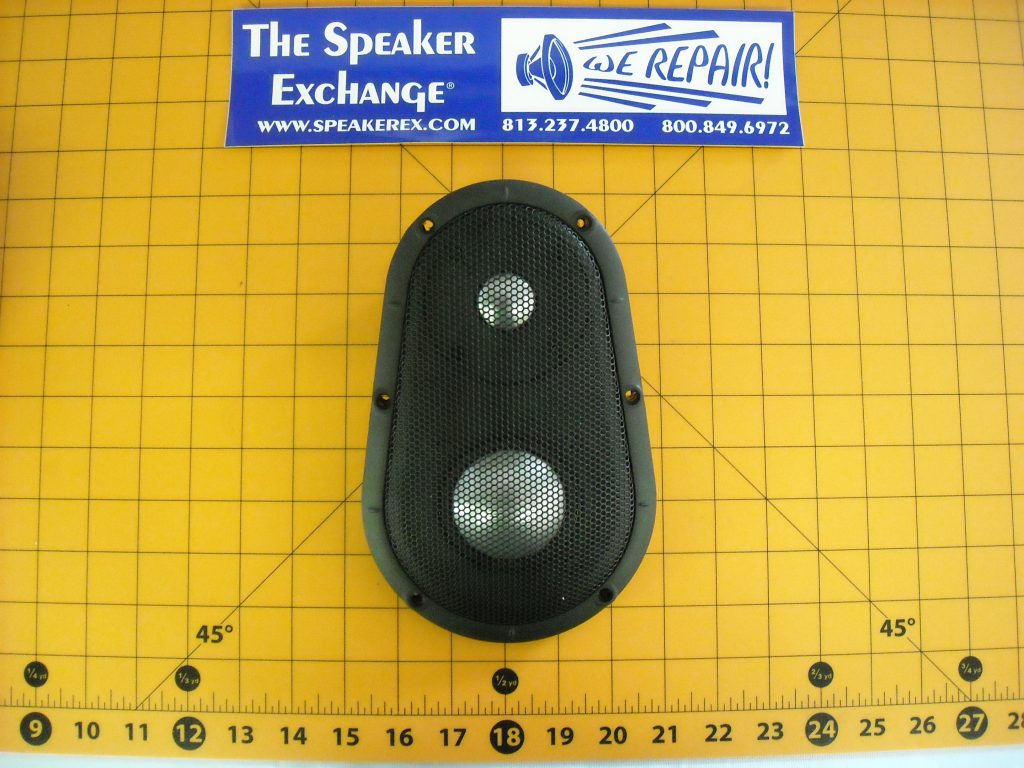
Something to keep in mind here, your network has a few LCR notch filters dialed in to deal with the inevitable aluminum breakups >> those will need to be tweaked by a Pro if you substitute in a different tweeter.
Last edited:
I also imagine that the width of the mesh covering the midrange and tweeter, when measured horizontally across the tweeter face is the diameter of the faceplate for a replacement tweeter. Give or take a mm.
You will also need to measure across the disconnected good one to find the resistance of the coil.
I would hang in there and try and get them working again, especially as you have had them so long and have been happy, a lot of effort went into the crossover, you don't very often see something as complex as that.
You will also need to measure across the disconnected good one to find the resistance of the coil.
I would hang in there and try and get them working again, especially as you have had them so long and have been happy, a lot of effort went into the crossover, you don't very often see something as complex as that.
This appears to have been rewired.
+1/ That thick stranded wire is out of place — and from experience, may actually be counterproductive. I really doubt that such thick wire was factory.
The best tweeter will be the same as the factory one. 25 years old (1995 vintage) is kinda old to hope that a replacement tweeter has survived with Energy going thru a number of owners, but it is worth checking.
How about a decent picture of the front of the tweeter.
dave
Ok, that's some good steps to pursue. I will get to pulling the tweeters out tomorrow perhaps. Taking the sticker off makes sense to see if there is an OEM part # or other such info underneath that won't mean anything to me but someone knowledgeable here may see as relevant.
From the info on the crossover drawing it does say 12 Ga wire so the wiring seems factory correct and so I am thinking likely untouched.
Not opposed to sending the tweeters out for potential repair or to put in the hands of someone who can better select a suitable replacement.
From the info on the crossover drawing it does say 12 Ga wire so the wiring seems factory correct and so I am thinking likely untouched.
Not opposed to sending the tweeters out for potential repair or to put in the hands of someone who can better select a suitable replacement.
Had some time so went into this further.
Under the sticker is "5DR52022. L21TND" Made in Japan
Approx 70 mm diameter, 24 mm thick, 47 mm bolt circle diameter, dome approx 26 mm.
Rechecked my ohms and still open. Leads off terminal connection to voice coil look intact.
Mid range is 4.0 ohm, just for posterity.
The other tweeter is failed so haven't attempted an ohm check on it. What ever I do to one I will do with the other.
Any thoughts on what might be a suitable replacement would be appreciated. Sending out for evaluation / possible repair or have someone look at it more closely to provide a good alternative replacement is what would make me most comfortable.
Thanks
Under the sticker is "5DR52022. L21TND" Made in Japan
Approx 70 mm diameter, 24 mm thick, 47 mm bolt circle diameter, dome approx 26 mm.
Rechecked my ohms and still open. Leads off terminal connection to voice coil look intact.
Mid range is 4.0 ohm, just for posterity.
The other tweeter is failed so haven't attempted an ohm check on it. What ever I do to one I will do with the other.
Any thoughts on what might be a suitable replacement would be appreciated. Sending out for evaluation / possible repair or have someone look at it more closely to provide a good alternative replacement is what would make me most comfortable.
Thanks
Attachments
Thanks for the pics Ken!
If mine ( & I was wanting to save the speakers ) I would ditch the plastic ( tear-drop shaped ) insert and build a new one made from 5/16" multiply baltic-birch plywood .
- Making a new insert ( with the correct sized holes for a new tweeter ) will be infinitely simpler than trying to fit a new tweeter to the cut-out in that plastic insert .
The advantage you have here ( for retrofitting any new tweeter ) is the existing large cutout within the cabinet ( behind the plastic insert ) needing an insert to fill the hole in.
That large space allows you to choose from a pretty wide assortment of aluminum domed tweeters ( that will undoubtedly need a custom fit into a non-existent baffle ).
Solen out of Montreal offers a few affordable alu-domed tweeters.
I'd choose the one with the best looking off-axis dispersion ( which oddly enough seems to be the Dayton in the under $50. category ).

If mine ( & I was wanting to save the speakers ) I would ditch the plastic ( tear-drop shaped ) insert and build a new one made from 5/16" multiply baltic-birch plywood .
- Making a new insert ( with the correct sized holes for a new tweeter ) will be infinitely simpler than trying to fit a new tweeter to the cut-out in that plastic insert .
The advantage you have here ( for retrofitting any new tweeter ) is the existing large cutout within the cabinet ( behind the plastic insert ) needing an insert to fill the hole in.
That large space allows you to choose from a pretty wide assortment of aluminum domed tweeters ( that will undoubtedly need a custom fit into a non-existent baffle ).
Solen out of Montreal offers a few affordable alu-domed tweeters.
I'd choose the one with the best looking off-axis dispersion ( which oddly enough seems to be the Dayton in the under $50. category ).
Last edited:
I see where you are going Earl. There is a recessed cutout about 3/8" deep in the cabinet so could make a plate, put original mid range into it and cut hole for tweeter to fit whatever I purchase. Some varnish on the adapter plate, paint it black, and would be ok. Grills stay in place all the time anyway.
I never did find that same tweet/mid assembly shown in your first post though.
I see why people are building their own speakers. When I was a much younger guy it was a Radio Shack catalogue and whatever fit the hole. Now the possibilities are endless.
What are the criteria for choosing a tweeter then, if I make a plate to accommodate whatever package I choose. Not too worried about price. A $100 tweeter is not expensive in the big picture. More concerned with the tweeter being too forward or subdued. Don't know if crossover would need tweaking to accommodate different tweeter. These are the pieces of information I need from a qualified speaker person to step me through. Stay with same dome material and diameter or change? I looked through Solen and Speaker Exchange and there are so many choices and I don't know enough to know what criteria to narrow down the options.
I never did find that same tweet/mid assembly shown in your first post though.
I see why people are building their own speakers. When I was a much younger guy it was a Radio Shack catalogue and whatever fit the hole. Now the possibilities are endless.
What are the criteria for choosing a tweeter then, if I make a plate to accommodate whatever package I choose. Not too worried about price. A $100 tweeter is not expensive in the big picture. More concerned with the tweeter being too forward or subdued. Don't know if crossover would need tweaking to accommodate different tweeter. These are the pieces of information I need from a qualified speaker person to step me through. Stay with same dome material and diameter or change? I looked through Solen and Speaker Exchange and there are so many choices and I don't know enough to know what criteria to narrow down the options.
Attachments
I don't suppose that you live in Montreal do you?
If so then you could bundle up those speakers and take them over to Solen for some custom crossover work ( after you've chosen a tweeter or two for them to try out ) .
I would try to keep the same voicing ( iow; keep an all metal mid and tweeter ).
You'd want an aluminum dome of some small size ( 1" or less though I can't find a 3/4" aluminum dome in Solens catalog. Tweeter sensitivity needs to be over 90db ( to use all the existing LCR components in your network ).
Tweeter impedance ( as a guess ) should be 4 to 6 ohms.
Solen might interested in doing this retro/design work ( for a reduced price ) and then offering it as an option to sell other users who want to keep their Energy Veritas speakers going after tone has packed in a tweeter.
If trying to accomplish this through the mail then you'd need to construct a plate and mount a mid on it with a hole waiting for a tweeter to be installed. You would send in one network for them to modify with tweaked passive components to re-balance new tweeter to the existing midrange.
Of course getting that 3" mid safely through the mail ( twice ) without the dome getting punched would be it's own challenge in protective packing.

If so then you could bundle up those speakers and take them over to Solen for some custom crossover work ( after you've chosen a tweeter or two for them to try out ) .
I would try to keep the same voicing ( iow; keep an all metal mid and tweeter ).
You'd want an aluminum dome of some small size ( 1" or less though I can't find a 3/4" aluminum dome in Solens catalog. Tweeter sensitivity needs to be over 90db ( to use all the existing LCR components in your network ).
Tweeter impedance ( as a guess ) should be 4 to 6 ohms.
Solen might interested in doing this retro/design work ( for a reduced price ) and then offering it as an option to sell other users who want to keep their Energy Veritas speakers going after tone has packed in a tweeter.
If trying to accomplish this through the mail then you'd need to construct a plate and mount a mid on it with a hole waiting for a tweeter to be installed. You would send in one network for them to modify with tweaked passive components to re-balance new tweeter to the existing midrange.
Of course getting that 3" mid safely through the mail ( twice ) without the dome getting punched would be it's own challenge in protective packing.
This appears to have been rewired. Is the discolouration beneath the blue capacitors some kind of chemical residue?
It's probably either hot glue or silicone, used to keep the parts from rattling against the board with woofer vibration. It's pretty common on crossovers.
- Home
- Loudspeakers
- Multi-Way
- Energy Veritas 1.8 tweeters quit
